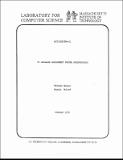On Database Management System Architecture
Author(s)
Hammer, Michael; McLeod, Dennis
DownloadMIT-LCS-TM-141.pdf (14.30Mb)
Metadata
Show full item recordAbstract
Despite the many advances that have been made in the field of database management in the last two decades, in many respects the paradigm of database management has not changed much since its inception. Several long-standing assumptions pervade the field and exert a great influence on the architecture of database management systems, their functions, and. the kinds of databases that they manage. This paper reconsiders some of these assumptions and suggests certain alternatives to them. In particular, it is argued that the concept of an integrated database ought to be supplanted by that of a federated database, a loose assembly of semi-independent components; the position of the database management system in the context of a total information system is reexamined, and arguments are made for extending its functional capabilities; and controlled logical redundancy in the schema is introduced as a means of improving the usability of a database and of enhancing its life-cycle performance. An underlying theme throughout is that of the importance of a semantic schema of the database, which specifies enough of the meaning of the application domain to enable enhanced functionality to be achieved. A number of characteristics of a conceptual data model (in which this scheme would be expressed) are described.
Date issued
1979-10Series/Report no.
MIT-LCS-TM-141